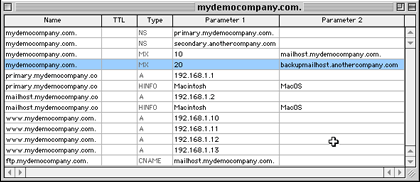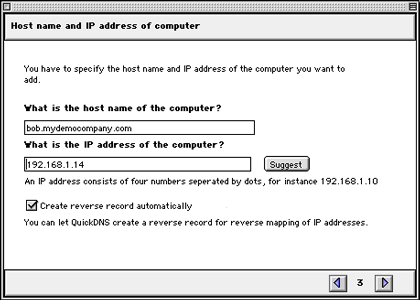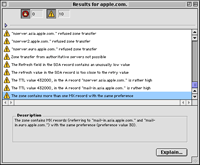Review: QuickDNS Pro 2.2.1/
DNS Expert Standard 1.5.1

Published by: Men and Mice Software
E-Mail: sales@menandmice.com
Web: http://www.menandmice.com
Price: $290 (includes DNS Expert Standard);
w/DNS Expert Pro: $395
When Apple released AppleShare IP, the Macintosh community rejoiced. Especially with the release of version 6.2, Apple has proven that a Macintosh can hold its own as a server in a small to midrange network, and that there is no server platform easier to configure and maintain than the Macintosh. Yet with as many positive changes as Apple has made to AppleShare and its provisions, one component of Macintosh server technology has remained dreadfully unchanged: Mac DNS.
Decrepit DNS
Mac DNS has two positive attributes: it works and it’s free. But aside from that, most server admins find it to be a bit of a joke. For starters, it’s not even PowerPC native; it runs entirely under the 68K emulator! And even if it were native, chances are it still wouldn’t be all that fast relative to NT or UNIX’s DNS servers, based on its miserable performance under emulation. Worse yet, Mac DNS only provides primary DNS services. That is to say, it cannot serve as a secondary DNS server. With respect to user friendliness, if a user is well versed in DNS or network administration, Mac DNS’ interface will suffice, but for less savvy users, there is little in the way of support or assistance from the interface.

DNS Done Right
Enter QuickDNS from Men and Mice Software. Quick DNS is the de facto standard for DNS services on the Macintosh platform. It is quite fast, even when compared to UNIX or NT (see this site ), it provides excellent “assistants” which prove useful even for experienced users, and it provides secondary server functionality. QuickDNS also includes DNS Expert Standard, a wonderful tool for analyzing DNS configurations and insuring that a network is running as efficiently and securely as possible. There is a Professional edition of DNS Expert which offers a greater level of sophistication and may be purchased separately or in a bundle with QuickDNS Pro for an additional $105. Also worth noting is that DNS Expert is available for Windows. DNS Expert is an entirely separate application and does not require QuickDNS to be running or present on the same machine or network.
QuickDNS is comprised of two separate applications: QuickDNS Server and QuickDNS Admin. They are fairly self explanatory. The Admin program enables the user to create and configure domains, and the Server application handles and logs DNS requests. You need not have the QuickDNS Server running while you configure domains in QuickDNS Admin, but if you do, the Admin app will force the server to reload all its data to guarantee that your changes take effect immediately.
My Very First Domain Name
Setting up a domain in QuickDNS is quite simple. There are several thoroughly commented examples included with QuickDNS which help acquaint a beginner with the syntax and jargon of DNS. Should this not be enough, the Domain Assistant will guide the user through the process of generating a domain step by step. QuickDNS’ manual is also outstanding and provides a wealth of information for beginners and experienced users alike.

For more experienced users, QuickDNS provides the ability to bypass the assistants and allows the user to create an empty domain and create and configure DNS records by hand, a method with which most admins are familiar. I must say, however, that I appreciate the automation which the assistants provide. I find that often they save me time by properly generating the reverse domain entries and the host info (HINFO) records for me.
The Juggling Routine
Many admins may not have a use for QuickDNS’ more sophisticated features, but some surely will. Setting up a domain for load sharing is a trivial task in QuickDNS. For example, should a network have four mirrored Web servers which are to be set up for load sharing, QuickDNS can simply send one request to each server in a round robin fashion for every www. request it receives. QuickDNS can also create load balancing records.
Furthermore, QuickDNS can easily be configured as a secondary, or “slave” server. Included with every license of QuickDNS is the right to run two copies at once, one as a primary server and one as a secondary server. Once the primary server is configured, all the user must do is provide the IP address of the primary server and tell the secondary server to run in slave mode. The secondary server will then store a local copy of the data from the primary server and update based on the primary server at a user-defined interval.
Other Niceties
QuickDNS can also be configured to talk to WebStar using the WebStar Plug-In. QuickDNS can be configured to restrict zone transfers for enhanced security, and the user can choose from one of six levels of logging. Another nice touch: QuickDNS can communicate directly with Sophisticated Circuits’ Rebound or PowerKey Pro (see my review of the PowerKey Pro 600 in ATPM 5.08).
DNS Expert
As if QuickDNS wasn’t enough to make an admin smile, DNS Expert is an added bonus. According to Men and Mice, roughly 3 out of 4 DNS servers on the net are improperly configured. Some of these configuration errors lead to inefficiency while others could lead to security problems. Providing fully configurable levels of analysis, DNS Expert will query a DNS server to test it for proper configuration and to insure that it is as secure and efficient as possible. It returns its results as a list of warnings and errors. Should the user desire a further explanation of the error or window, all he need do is double click the item in question and he will be taken to a Web page which specifically addresses the warning or error. Very slick indeed.
DNS Expert also provides very nice Ping, Query, and Traceroute functionality. When appropriate, DNS Expert will return and graphs or histograms in addition to statistics: a nice touch.
Final Thoughts
 QuickDNS is representative of my ideal for Macintosh software. The Admin app is small, fast, and easy to configure for experienced users. The interface is simple and uncluttered but helpful in every way possible for both beginners and savvy admins alike. The server itself is a small and extremely fast application with minimal requirements and overhead. The feature set is as extensive as one could want or need. DNS Expert simply elevates the level of quality and functionality of the package. Much like QuickDNS, the interface is elegant and intuitive, yet it does everything it needs to quickly and properly. Retrieving explanations for warnings and errors via the Web is slick. The polished facilities for Trace, Ping, and Query are appreciated as well. DNS Expert is an invaluable tool for any administrator and should be used to test every DNS server possible.
QuickDNS is representative of my ideal for Macintosh software. The Admin app is small, fast, and easy to configure for experienced users. The interface is simple and uncluttered but helpful in every way possible for both beginners and savvy admins alike. The server itself is a small and extremely fast application with minimal requirements and overhead. The feature set is as extensive as one could want or need. DNS Expert simply elevates the level of quality and functionality of the package. Much like QuickDNS, the interface is elegant and intuitive, yet it does everything it needs to quickly and properly. Retrieving explanations for warnings and errors via the Web is slick. The polished facilities for Trace, Ping, and Query are appreciated as well. DNS Expert is an invaluable tool for any administrator and should be used to test every DNS server possible.
Most Macintosh administrators don’t really give QuickDNS a second thought. For anybody serious about running DNS on a Mac, it’s the only choice. Upon using QuickDNS, it becomes obvious why Apple hasn’t bothered to update Mac DNS. They would be hard pressed to match the elegance and performance of QuickDNS, and it wouldn’t be worth their while to try.
Reader Comments (0)
Add A Comment